-
 Bitcoin
Bitcoin $114400
0.68% -
 Ethereum
Ethereum $3550
2.48% -
 XRP
XRP $3.001
4.99% -
 Tether USDt
Tether USDt $0.9999
0.01% -
 BNB
BNB $757.6
1.46% -
 Solana
Solana $162.9
1.07% -
 USDC
USDC $0.9998
0.00% -
 TRON
TRON $0.3294
0.91% -
 Dogecoin
Dogecoin $0.2015
2.46% -
 Cardano
Cardano $0.7379
2.01% -
 Stellar
Stellar $0.4141
8.83% -
 Hyperliquid
Hyperliquid $37.83
-1.91% -
 Sui
Sui $3.454
0.76% -
 Chainlink
Chainlink $16.62
3.53% -
 Bitcoin Cash
Bitcoin Cash $554.6
2.84% -
 Hedera
Hedera $0.2486
3.91% -
 Ethena USDe
Ethena USDe $1.001
0.00% -
 Avalanche
Avalanche $21.95
3.34% -
 Toncoin
Toncoin $3.563
-2.85% -
 Litecoin
Litecoin $112.7
2.65% -
 UNUS SED LEO
UNUS SED LEO $8.977
0.13% -
 Shiba Inu
Shiba Inu $0.00001232
1.85% -
 Uniswap
Uniswap $9.319
2.93% -
 Polkadot
Polkadot $3.632
1.38% -
 Monero
Monero $307.2
2.36% -
 Dai
Dai $0.9997
-0.03% -
 Bitget Token
Bitget Token $4.340
0.91% -
 Pepe
Pepe $0.00001048
1.07% -
 Cronos
Cronos $0.1348
3.26% -
 Aave
Aave $261.5
1.93%
Which is more accurate, RSI or KDJ? Can they be used together?
RSI is more reliable in ranging markets, while KDJ excels in trending markets; using both can enhance trading strategies in cryptocurrency trading.
May 22, 2025 at 10:56 pm
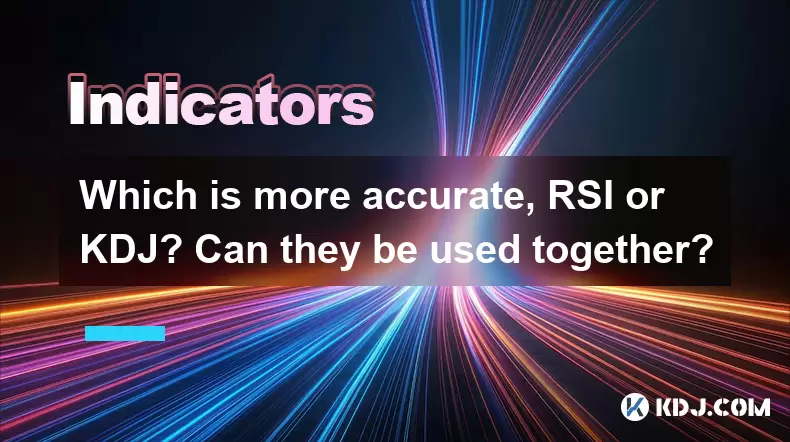
In the world of cryptocurrency trading, technical indicators play a crucial role in helping traders make informed decisions. Two popular indicators that traders often use are the Relative Strength Index (RSI) and the KDJ indicator. Both are momentum oscillators used to determine overbought and oversold conditions in the market, but they have their unique characteristics and applications. This article will explore the accuracy of RSI and KDJ, and whether they can be effectively used together.
Understanding the RSI Indicator
The Relative Strength Index (RSI) is a momentum oscillator that measures the speed and change of price movements. Developed by J. Welles Wilder, RSI is calculated based on the average gain and loss over a specific period, typically 14 days. The RSI value ranges from 0 to 100, with readings above 70 indicating overbought conditions and readings below 30 indicating oversold conditions.
RSI is widely used because of its simplicity and effectiveness in identifying potential reversal points in the market. Traders often look for divergence between the RSI and price action as a signal for potential trend reversals. For instance, if the price of a cryptocurrency is making higher highs while the RSI is making lower highs, it could be a sign of a bearish divergence, suggesting a possible downward reversal.
Understanding the KDJ Indicator
The KDJ indicator, also known as the Stochastic Oscillator, is another momentum indicator used to identify overbought and oversold conditions. The KDJ is derived from the Stochastic Oscillator and includes three lines: K, D, and J. The K line represents the current market momentum, the D line is a moving average of the K line, and the J line is a more sensitive indicator that can provide early signals.
The KDJ indicator ranges from 0 to 100, similar to the RSI. Readings above 80 typically indicate overbought conditions, while readings below 20 indicate oversold conditions. The KDJ is particularly useful in trending markets, as it can help traders identify potential entry and exit points based on the crossover of the K and D lines.
Comparing the Accuracy of RSI and KDJ
When it comes to accuracy, both the RSI and KDJ have their strengths and weaknesses. RSI is generally considered more reliable in ranging markets, where prices fluctuate within a specific range. It is effective in identifying overbought and oversold conditions, making it a popular choice among traders looking to capitalize on short-term price movements.
On the other hand, KDJ is often preferred in trending markets. The KDJ's sensitivity to price movements allows it to provide earlier signals, which can be advantageous in capturing trends early. However, this sensitivity also means that the KDJ can produce more false signals, especially in volatile markets.
In terms of accuracy, RSI tends to be more stable and less prone to false signals compared to KDJ. This is because RSI uses a longer period for its calculations, which smooths out the data and reduces the likelihood of whipsaws. However, the choice between RSI and KDJ ultimately depends on the trader's trading style and market conditions.
Using RSI and KDJ Together
While both RSI and KDJ can be used independently, many traders find that combining these two indicators can enhance their trading strategy. Using RSI and KDJ together can provide a more comprehensive view of market conditions and help confirm signals.
Here are some ways to use RSI and KDJ together effectively:
Confirming Overbought and Oversold Conditions: If both RSI and KDJ indicate overbought conditions (RSI above 70 and KDJ above 80), it can strengthen the signal that a price correction may be imminent. Similarly, if both indicators show oversold conditions (RSI below 30 and KDJ below 20), it may suggest a potential upward reversal.
Identifying Divergence: Traders can look for divergence between the price and both RSI and KDJ. If the price is making new highs while both RSI and KDJ are making lower highs, it could indicate a bearish divergence. Conversely, if the price is making new lows while both indicators are making higher lows, it could suggest a bullish divergence.
Combining Signals: Traders can use the crossover of the K and D lines in the KDJ as an entry signal, while using RSI to confirm the strength of the trend. For example, if the K line crosses above the D line in the KDJ while the RSI is above 50, it could be a strong buy signal.
Practical Application of RSI and KDJ in Cryptocurrency Trading
To illustrate how RSI and KDJ can be used together in cryptocurrency trading, let's consider a hypothetical example. Suppose a trader is analyzing the price chart of Bitcoin (BTC) and wants to use both RSI and KDJ to make trading decisions.
- Step 1: Open a trading platform and select the Bitcoin chart.
- Step 2: Add the RSI indicator to the chart with a period of 14.
- Step 3: Add the KDJ indicator to the chart with default settings.
- Step 4: Monitor the RSI and KDJ readings and look for overbought and oversold conditions. If both indicators show overbought conditions, the trader might consider selling or shorting BTC.
- Step 5: Watch for divergence between the price and both indicators. If the price is making new highs while both RSI and KDJ are making lower highs, it could be a signal to sell.
- Step 6: Use the crossover of the K and D lines in the KDJ as an entry signal, while using RSI to confirm the trend's strength. If the K line crosses above the D line while the RSI is above 50, it could be a strong buy signal.
By combining the signals from both RSI and KDJ, the trader can make more informed decisions and potentially improve their trading performance.
Limitations of RSI and KDJ
While RSI and KDJ are powerful tools, they are not without limitations. RSI can sometimes remain in overbought or oversold territory for extended periods during strong trends, leading to false signals. Similarly, KDJ's sensitivity can result in whipsaws and false signals in volatile markets.
Traders should always use these indicators in conjunction with other technical analysis tools, such as moving averages, trend lines, and volume indicators, to validate their trading decisions. Additionally, it's essential to consider the broader market context and news events that could impact cryptocurrency prices.
Frequently Asked Questions
Q1: Can RSI and KDJ be used for long-term trading in cryptocurrencies?
While RSI and KDJ are primarily used for short-term trading due to their sensitivity to price movements, they can still be useful in long-term trading. For long-term analysis, traders might adjust the periods used in the calculations to smooth out the data and focus on broader trends. For example, using a longer period for RSI, such as 21 or 28 days, can help identify longer-term overbought and oversold conditions.
Q2: How do I adjust the settings of RSI and KDJ for different cryptocurrencies?
The settings for RSI and KDJ can be adjusted based on the volatility and trading characteristics of different cryptocurrencies. For highly volatile cryptocurrencies like Bitcoin or Ethereum, traders might use shorter periods for both indicators to capture rapid price movements. For less volatile cryptocurrencies, longer periods might be more appropriate. It's essential to backtest different settings to find the optimal configuration for each cryptocurrency.
Q3: Are there any other indicators that work well with RSI and KDJ in cryptocurrency trading?
Yes, several other indicators can complement RSI and KDJ in cryptocurrency trading. Moving averages, such as the Simple Moving Average (SMA) and Exponential Moving Average (EMA), can help confirm trends identified by RSI and KDJ. The Moving Average Convergence Divergence (MACD) can also be useful for identifying momentum shifts and trend reversals. Additionally, volume indicators like the On-Balance Volume (OBV) can provide insights into the strength of price movements.
Q4: How can I avoid false signals when using RSI and KDJ in cryptocurrency trading?
To avoid false signals, traders should use multiple timeframes for analysis. For example, if a signal appears on a shorter timeframe, such as a 15-minute chart, it should be confirmed on a longer timeframe, like a daily chart. Additionally, combining RSI and KDJ with other technical indicators and considering the overall market context can help filter out false signals. It's also crucial to set stop-loss orders to manage risk effectively.
Disclaimer:info@kdj.com
The information provided is not trading advice. kdj.com does not assume any responsibility for any investments made based on the information provided in this article. Cryptocurrencies are highly volatile and it is highly recommended that you invest with caution after thorough research!
If you believe that the content used on this website infringes your copyright, please contact us immediately (info@kdj.com) and we will delete it promptly.
- Cryptocurrency, Altcoins, and Profit Potential: Navigating the Wild West
- 2025-08-04 14:50:11
- Blue Gold & Crypto: Investing Disruption in Precious Metals
- 2025-08-04 14:30:11
- Japan, Metaplanet, and Bitcoin Acquisition: A New Era of Corporate Treasury?
- 2025-08-04 14:30:11
- Coinbase's Buy Rating & Bitcoin's Bold Future: A Canaccord Genuity Perspective
- 2025-08-04 14:50:11
- Coinbase's Buy Rating Maintained by Rosenblatt Securities: A Deep Dive
- 2025-08-04 14:55:11
- Cryptos, Strategic Choices, High Returns: Navigating the Meme Coin Mania
- 2025-08-04 14:55:11
Related knowledge
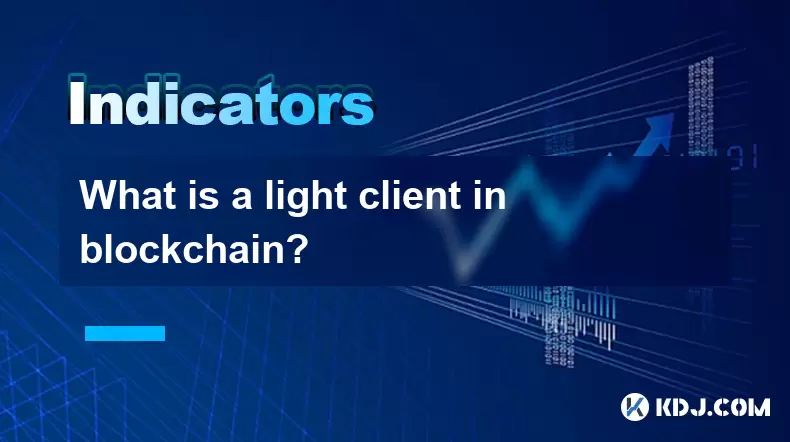
What is a light client in blockchain?
Aug 03,2025 at 10:21am
Understanding the Role of a Light Client in Blockchain NetworksA light client in blockchain refers to a type of node that interacts with the blockchai...

Is it possible to alter or remove data from a blockchain?
Aug 02,2025 at 03:42pm
Understanding the Immutable Nature of BlockchainBlockchain technology is fundamentally designed to ensure data integrity and transparency through its ...
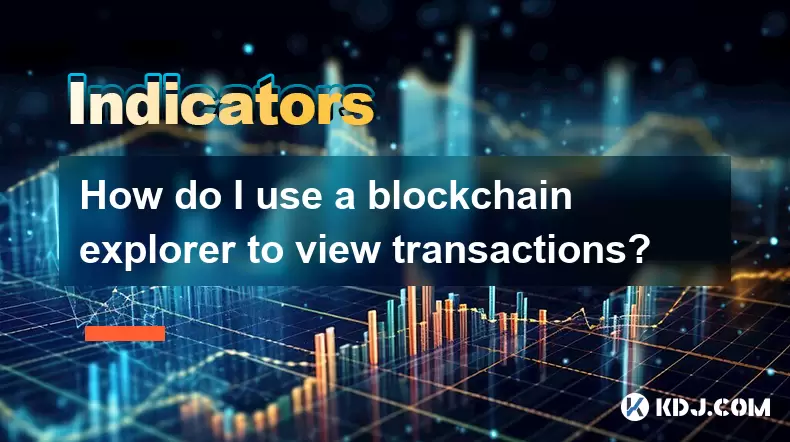
How do I use a blockchain explorer to view transactions?
Aug 02,2025 at 10:01pm
Understanding What a Blockchain Explorer IsA blockchain explorer is a web-based tool that allows users to view all transactions recorded on a blockcha...
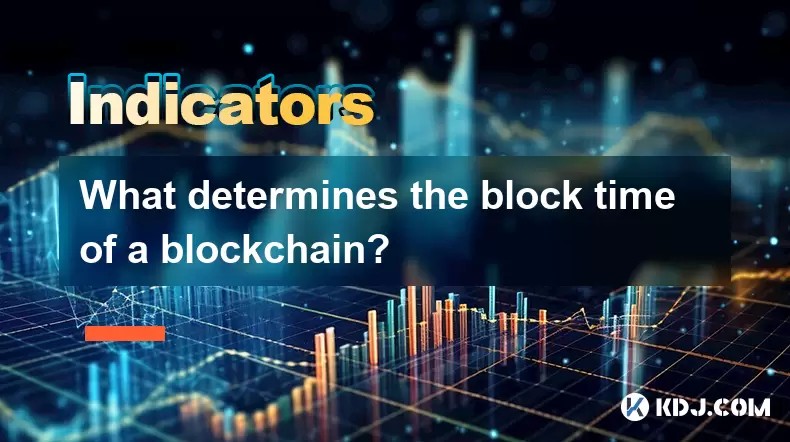
What determines the block time of a blockchain?
Aug 03,2025 at 07:01pm
Understanding Block Time in Blockchain NetworksBlock time refers to the average duration it takes for a new block to be added to a blockchain. This in...
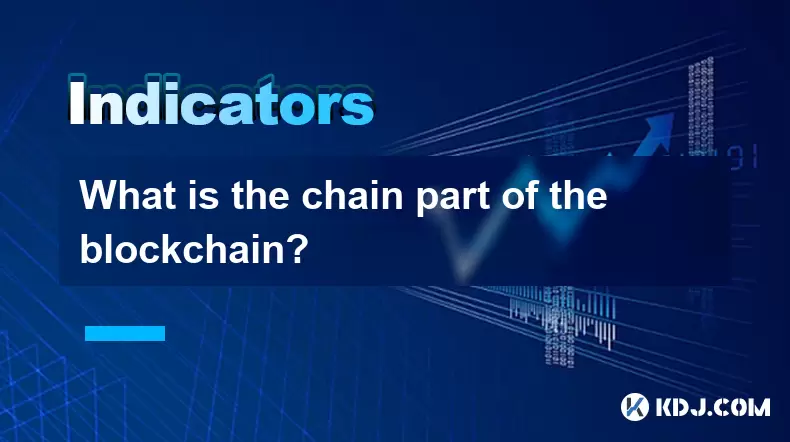
What is the chain part of the blockchain?
Aug 02,2025 at 09:29pm
Understanding the Concept of 'Chain' in BlockchainThe term 'chain' in blockchain refers to the sequential and immutable linkage of data blocks that fo...
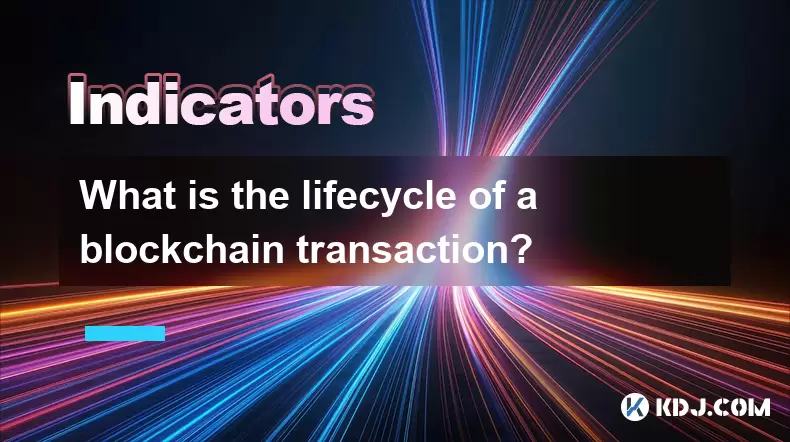
What is the lifecycle of a blockchain transaction?
Aug 01,2025 at 07:56pm
Initiation of a Blockchain TransactionA blockchain transaction begins when a user decides to transfer digital assets from one wallet to another. This ...

What is a light client in blockchain?
Aug 03,2025 at 10:21am
Understanding the Role of a Light Client in Blockchain NetworksA light client in blockchain refers to a type of node that interacts with the blockchai...

Is it possible to alter or remove data from a blockchain?
Aug 02,2025 at 03:42pm
Understanding the Immutable Nature of BlockchainBlockchain technology is fundamentally designed to ensure data integrity and transparency through its ...

How do I use a blockchain explorer to view transactions?
Aug 02,2025 at 10:01pm
Understanding What a Blockchain Explorer IsA blockchain explorer is a web-based tool that allows users to view all transactions recorded on a blockcha...

What determines the block time of a blockchain?
Aug 03,2025 at 07:01pm
Understanding Block Time in Blockchain NetworksBlock time refers to the average duration it takes for a new block to be added to a blockchain. This in...

What is the chain part of the blockchain?
Aug 02,2025 at 09:29pm
Understanding the Concept of 'Chain' in BlockchainThe term 'chain' in blockchain refers to the sequential and immutable linkage of data blocks that fo...

What is the lifecycle of a blockchain transaction?
Aug 01,2025 at 07:56pm
Initiation of a Blockchain TransactionA blockchain transaction begins when a user decides to transfer digital assets from one wallet to another. This ...
See all articles

























































































